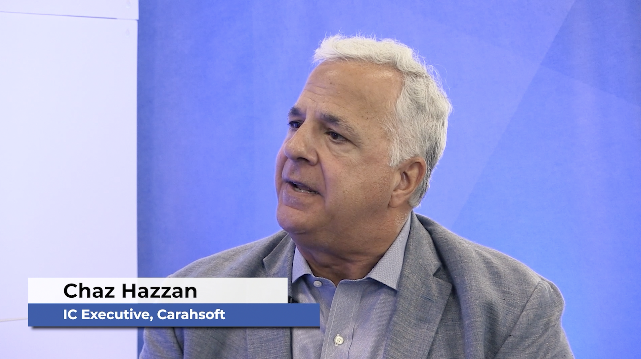Original broadcast 11/19/25
Presented by ServiceNow & Carahsoft
Modern defense operations depend on speed, collaboration, and cloud-enabled infrastructure. But what happens when those systems—designed for hyperconnectivity—suddenly go dark? At TechNet Indo-Pacific, Adam Prem, Global Public Sector Lead for Defense and Intelligence at ServiceNow, explored one of the most consequential and underexamined risks facing military and government operations today: the disconnect scenario.
A disconnect scenario occurs when a force, region, or entire nation suddenly loses access to the internet or to mission-critical cloud services. Prem identifies two primary vectors for this risk. The first is tactical and localized: naval vessels, aircraft, and forward-deployed units regularly operate in degraded or denied communications environments. These units must maintain continuity of operations even when connectivity is intermittent or unavailable.
 The second vector is strategic. Adversaries understand that the United States relies heavily on cloud-based workflows, collaboration tools, and digital infrastructure. Increasingly, experts believe that a first strike in a major conflict would target electrical grids, undersea cables, internet backbones, or satellite links—not to disable weapons systems directly, but to sever the digital nervous system that connects them.
The second vector is strategic. Adversaries understand that the United States relies heavily on cloud-based workflows, collaboration tools, and digital infrastructure. Increasingly, experts believe that a first strike in a major conflict would target electrical grids, undersea cables, internet backbones, or satellite links—not to disable weapons systems directly, but to sever the digital nervous system that connects them.
If such a disruption occurred, any organization with a cloud-only architecture would experience immediate operational paralysis. Planning data, situational awareness tools, logistics workflows, personnel systems, and intelligence products could become instantly unreachable. “They go back to the Stone Age,” Prem warns, not because the systems are inadequate, but because the data they rely on no longer exists locally.
This fragility reveals a paradox in modern defense modernization: agencies have spent years migrating systems to the cloud, leveraging its scale, agility, and collaborative advantages. But in doing so, many have become dependent on the assumption that connectivity is always available. In the Indo-Pacific—with vast distances, contested environments, and adversaries actively probing communications—the assumption simply does not hold.
Prem argues that true mission resiliency requires a dual architecture: cloud-first for day-to-day operations, but with fully capable on-premise or locally hosted backups that can activate instantly when connectivity is disrupted. This is not merely redundant storage; it is an entire parallel operational environment capable of running critical workflows, hosting essential data, and enabling mission continuity until cloud access is restored.
This approach demands careful planning. Agencies must determine which data is most essential, which workflows must continue during a disruption, and which systems can safely degrade. Not everything needs to be mirrored locally, but the systems that support planning, tasking, logistics, intelligence, and command-and-control must have resilient pathways.
Prem stresses that agencies should reevaluate their modernization strategies and assumptions. The cloud offers tremendous benefits—speed, collaboration, elasticity, automation—but modernization must not create new vulnerabilities. Organizations should ask: What happens if the cord is cut? How long can we operate without cloud access? Who makes decisions in a disconnected environment? Do we have the authority, governance, and tools to execute locally?
Local environments must be more than simple failover systems. They should be active, synchronized environments that maintain version control, workflow continuity, and policy enforcement even when disconnected. This is where automation, orchestration, and platform integration become essential. If local systems fall out of sync—or if data is inconsistent when the cloud connection returns—mission integrity can degrade rapidly.
The Indo-Pacific provides the clearest lens for this challenge. In a region defined by distributed operations, coalition partnerships, and multiple classification levels, data must move fluidly across domains and among allied nations. Prem introduces the concept of elevated trust—a recognition that no nation can operate effectively in isolation. Sharing data across allies is no longer optional; it is mission-critical.
Yet elevated trust introduces risk. Different nations maintain different classification standards, different levels of technical maturity, and different cultural attitudes toward information sharing. A single unintended oversharing event can compromise relationships or reveal sensitive capabilities.
This is where Prem sees a transformative opportunity for AI-assisted governance. Instead of relying solely on human judgment, AI can monitor data exchanges in real time, identify sensitive content, enforce policy boundaries, and prevent accidental oversharing. As AI systems gain more sophisticated pattern-recognition and context-awareness, they can serve as impartial intermediaries—ensuring data moves where it should, and nowhere else.
The future of mission resiliency, Prem argues, lies at the intersection of automation, AI governance, and distributed architectures. Agencies must build cloud-enabled, AI-assisted, human-controlled systems capable of operating at full capacity even when disconnected from the broader digital ecosystem. The goal is not redundancy but continuity: maintaining mission workflows without interruption and reintegrating seamlessly once connectivity returns.
ServiceNow’s role in this future is to provide an integrated platform that supports workflow automation, data orchestration, and resilient architectures across both cloud and local environments. The platform enables agencies to manage incidents, maintain service continuity, and automate decisions even when networks are contested or cut.
For defense organizations in a theater as immense and adversarial as the Indo-Pacific, this resiliency is not a luxury—it is a necessity. The next disruption, whether natural or adversarial, will test the government’s resilience not in terms of hardware or weaponry, but in terms of digital continuity and information integrity.
Prem’s message is direct: modernization without resiliency is vulnerability. Only by preparing for disconnect scenarios—technically, organizationally, and culturally—can agencies maintain operational advantage in the most unpredictable and strategically vital region in the world.
Key Takeaways
-
Mission resiliency requires dual architectures: cloud-first operations paired with fully capable local backups.
-
Elevated trust across allies demands strong governance and AI-assisted protection against oversharing.
-
Agencies must prepare now for disconnect scenarios, where continuity—not connectivity—defines mission success.



